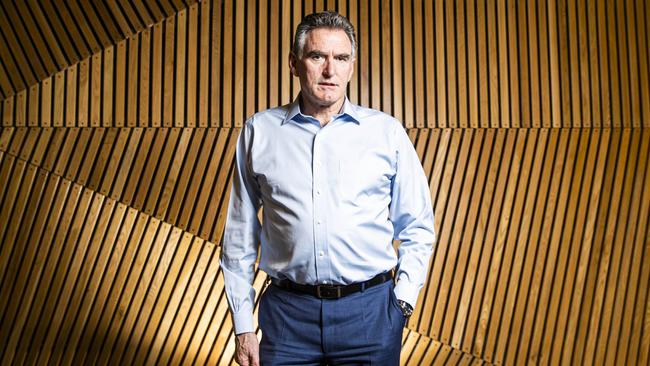Rapid growth in business lending lifts NAB earnings, dividend payments raised
The fastest growth in business lending in more than a decade and gains in the home loans market have pushed National Australia Bank’s first-half profit ahead of expectations.

The fastest growth in business lending in more than a decade and gains in the home loans market have pushed National Australia Bank’s first-half profit ahead of expectations and led the financial giant to lift dividend payments.
Ross McEwan, the NAB chief executive, said the company had made market share gains in home lending, business and unsecured loans, as well as deposits, as he announced an 8.2 per cent increase in cash earnings to $3.48bn.
Mr McEwan said the 6c increase in the interim dividend to 73c reflected progress in the bank’s strategy, confidence in the sustainability of its performance and optimism in the medium-term outlook for the Australian and New Zealand economies.
But the bank has scrapped a bid for an absolute reduction in costs as early as next year – it had aimed to lower operating expenses to $7.7bn – amid surging inflation and growth opportunities in a buoyant economy.
The move puts pressure on Westpac’s defining cost reduction program, put in place to restore its competitiveness, with ANZ also abandoning a similar cost-cutting project earlier this week.
Mr McEwan said the program would be scrapped because the environment had fundamentally changed from low growth and low interest rates to high growth and higher rates.
“We are seeing more really good growth opportunities across our business and we’re determined to seize them,” he said.
Westpac – which releases its interim profit on Monday – in November reported that it remained on track to achieve an $8bn cost base in 2024, despite a jump in expenses related to its risk management overhaul and pandemic-related issues.
Jefferies analyst Brian Johnson said the NAB and ANZ results put a spotlight emerging inflationary pressures as the revenue environment improved.
“Westpac continued to lose market share in March and April data, and we’ve seen the reintroduction of $4000 cashbacks for new mortgage lending, which will be a drag on the net interest margin,” Mr Johnson said.
“The bank’s inferior systems, processing and brand require a massive refresh to reverse weakening revenue.
“As the revenue environment improves, investment to harvest that opportunity is not consistent with the $8bn cost reset.”

Revenue growth at NAB was a highlight of Thursday’s result, rising 3.7 per cent, half on half, due to price discipline and strong growth in lending and deposits, up 10 per cent and 12 per cent respectively. “We are producing better and faster experiences and getting the basics right more consistently,” Mr McEwan said.
“This has been achieved during a period of increased customer activity across all divisions of the bank, including the fastest growth in business lending since the Global Financial Crisis.”
Despite the strong result, NAB retreated 19c to $332.25, partly because the bank is now widely held by investors as it successfully executes its turnaround.
The stock has also performed strongly in recent weeks in anticipation of a robust profit.
NAB’s total shareholder return – capital growth and dividends – leads the major banks over the last 12 months, up 27.2 per cent compared to Commonwealth Bank (20.9 per cent), Westpac (0.3 per cent) and ANZ (negative 0.1 per cent).
Barrenjoey bank analyst Jon Mott said NAB’s pre-provision profit matched consensus, with the trend in its underlying net interest margin better than its rivals and strong volume growth across the business. “While costs will be higher, we believe the market will continue to view NAB favourably,” Mr Mott said.
With its cost guidance discarded, NAB said it now expected cost growth of 2-3 per cent in the current financial year, with cumulative productivity benefits of more than $400m. This included an extra $80m-$120m a year for three years to comply with the recent enforceable undertaking signed with the financial intelligence agency Austrac.
One of the projects targeted for investment has been NAB’s bid to build the nation’s simplest home loan, which is scheduled for rollout in the 2024 financial year.
The objective is human intervention only by exception.
The median time to approve a simple home loan in the retail bank is already less than two days, with 35 per cent approved in less than an hour.
Responding to the 50 basis-point rate hike overnight by the US Federal Reserve — the biggest move since 2000 — Mr McEwan said he had not seen official rates move so quickly in his career, particularly after an 11-year downward cycle. He said the impact of higher rates would be unevenly felt, with households likely to bear the brunt because higher interest rates on their home loans would come at the same time as escalating food and energy prices.
While the impact in some cases would be significant, borrowers in general would be able to absorb the blow because the bank had stress-tested its home-loan customers at an interest rate of 2.75 to three percentage points higher than the product rate.
Also, most of the bank’s customers were four years ahead on their repayments. The SME sector, on the other hand, had demonstrated its resilience in the pandemic, with government support programs leaving the sector in “really good shape”.
NAB’s business bank hoped to take more market share off its rivals. “This is where growth in Australia will come from, along with infrastructure investment,” Mr McEwan said.
Meanwhile, the balance sheet remained strong with a common equity tier one ratio of 12.48 per cent at the end of March, despite completing a $2.5bn buyback and a further buyback of the same magnitude starting this month.
While NAB was anticipating a further three RBA increases this year, Australia as a large commodity exporter remained in a strong position to grow.





To join the conversation, please log in. Don't have an account? Register
Join the conversation, you are commenting as Logout